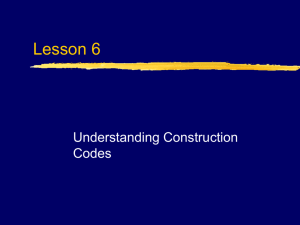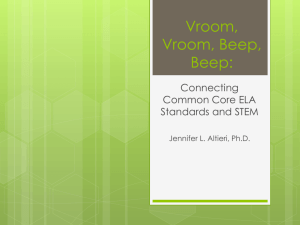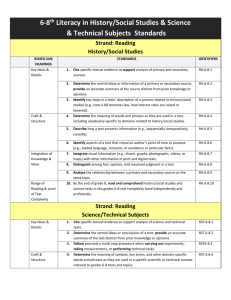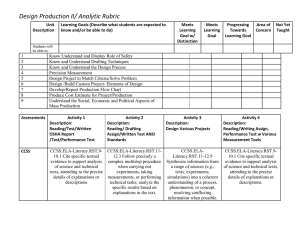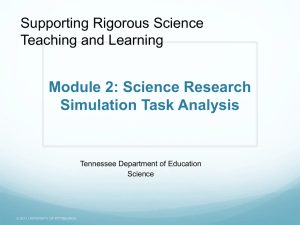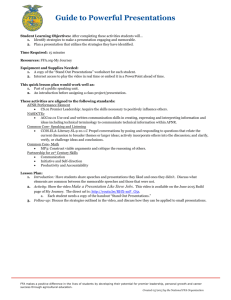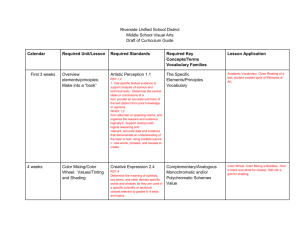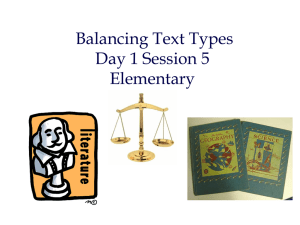Close Reading - Disciplinary Literacy
advertisement
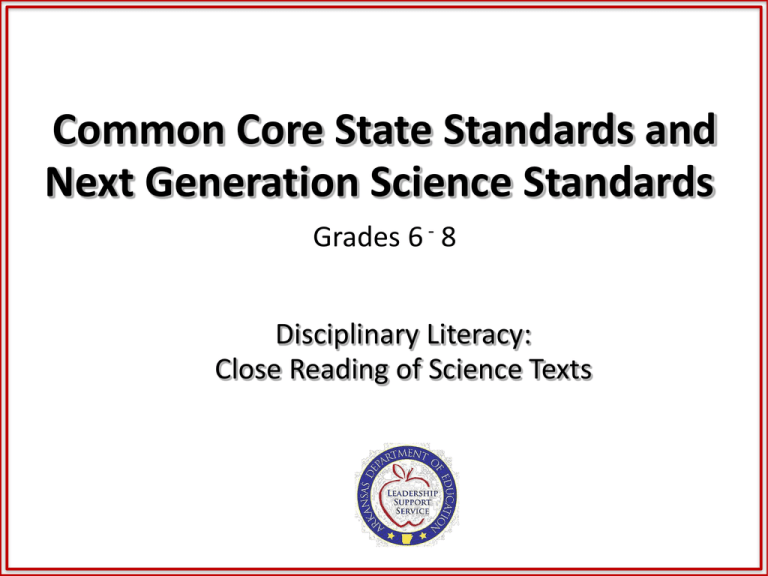
Common Core State Standards and Next Generation Science Standards Grades 6 - 8 Disciplinary Literacy: Close Reading of Science Texts Agenda: Close Reading – Welcome/Introductions • Outcomes – Investigate Common Core State Standards and Next Generation Science Standards – Close Reading • Establishing a Definition • Constructing a Routine • Purpose • Tools • Implementing Close Reading Outcomes: Close Reading Participants will: • Gain a working knowledge of Common Core State Standards (CCSS) and the Next Generation Science Standards (NGSS). • Practice and apply appropriate Close Reading strategies in various complex texts. • Develop a working knowledge of Close Reading in the science context. Questions to Ponder – What are some characteristics of an independent learner of science? – What are some characteristics of a literate person in science? – How might we move this vision forward? Introduction to Common Core State Standards Jigsaw: • (Group 1) Introduction- (p.3) • (Groups 2 and Group 3)What are the key design considerations and distributions? (pp.4-5) • (Group 4) What is not covered? (p.6) • (Group 5) What does it mean to be College and Career Ready (CCR)? (p.7) • (Group 6) How to read the document. (p.8) Investigating Science Literacy: Expectations of the CCSS Common Core State Standards for Literacy in Science and Technical Subjects CCSS RST 6-8- Reading Standards Addressed • RST.6-8.1- Cite specific textual evidence to support analysis of science and technical texts. • RST.6-8.2- Determine central ideas or conclusions of a text; provide an accurate summary of the text distinct from prior knowledge or opinions • RST.6-8.4- Determine the meaning of symbols, key terms, and other domain-specific words and phrases as they are used in context and relevant to grades 6-8. • RST.6-8.6- Analyze the author's purpose in providing an explanation, describing a procedure, or discussing an experiment in a text. Next Generation Science Standards Practices and Common Core State Standards How do the expectations of the Next Generation Science Standards (NGSS) for Science & Engineering Practices correlate with the Common Core State Standards for Science Literacy? Next Generation Science Standards Expectations By grade 12, students should be able to: • Use words, tables, diagrams, and graphs (whether in hard copy or electronic), as well as mathematical expressions, to communicate their understanding or to ask questions about a system under study. • Read scientific and engineering text, including tables, diagrams, and graphs, commensurate with their scientific knowledge and explain the key ideas being communicated. • Engage in a critical reading of primary scientific literature (adapted for classroom use) or of media reports of science and discuss the validity and reliability of the data, hypotheses, and conclusions. • Recognize the major features of scientific and engineering writing and speaking and be able to produce written and illustrated text or oral presentations that communicate their own ideas and accomplishments. Quick write How do you envision the Next Generation Science Practices and Common Core State Standards working together in a science classroom? What is Reading? “If we understand that reading is not just ‘receiving a message,’ but actively building meaning upon prior knowledge using staged, strategic thinking, then we will teach differently.” Subjects Matter, Daniels & Zemelman –p.31 “To Read” • The detective quickly reads the situation and decides upon an appropriate response. • The park ranger is always careful to read the skies when escorting hikers into the mountains. • The coach reads the opponents’ defense and immediately adjusts the next play. • The child tries to read his mother’s reaction to see if he will be permitted to play with his friends. Close Reading What does this term mean to you? Close Reading Why do students need to close read? Close Reading is… close sustained reading of grade-level appropriate complex texts to examine their meaning thoroughly and methodically, ultimately arriving at an understanding of the text as a whole. Close Reading is NOT… • skimming for answers. • surface processing. • reading and forgetting. Close Reading in CCSS read closely work diligently to understand precisely ability to discern focusing reading attention to precise detail wide, deep, and thoughtful engagement close, attentive reading careful attention to specific passages close sustained reading “read like a detective” read purposefully Close Reading • Reading to infer/interpret/draw conclusions • Supporting arguments with evidence • Resolving conflict with views encountered in source documents • Solving complex problems Close reading involves: - getting “into” a text, - going “through” a text by annotating, asking questions, and discussing it, - going “beyond” the text to deepen understanding. Close Reading Behaviors Implementing Close Reading 1. Pre-teach the vocabulary and concepts 2. Set a purpose for reading 3. Model close reading 4. Provide guided practice 5. Provide independent practice 6. Organize discussions and debates 7. Have students write about the text Power of “Think Alouds” Step 3: Model Close Reading • Modeling is best accomplished by a “think aloud.” • Modeling is a critical step in instruction. • “Teachers have to ‘think aloud’ to demystify how to select the best quotes, facts, and data: how to make lists and outlines; and how, for more formal assignments, to make adjustments…” M. Schmoker, Focus, p. 87 Close Reading Tools Six tools for Close Reading: 1. SOAPS- Subject, Occasion, Audience, Purpose, Speaker 2. Connections- Text-to-Text, Text-to-Self, Text-to-World 3. Three Levels of Questions 4. Arguments and Evidence 5. Appeals- Logic, Ethical, and Emotional 6. Assumptions Applying Close Reading Tools to an Article - Use SOAPS to closely read the Scientific American article Who Owns the Past? - After utilizing other tools, which ones seem to work best for this article? What were the indicators that determined whether a tool worked or not? Reading Graphs and Charts How does Close Reading apply to reading a chart or graph? Close Reading Practice Using the Tools Annotate - Global Thermometer Still Climbing Reflection • Which close reading skills do I most want my students to learn and practice? • Which close reading tools will I model for my students and ask them to use? • Which steps of the close reading routine will I utilize? Adapted from the Consortium on Reaching Excellence in Education, Inc.

